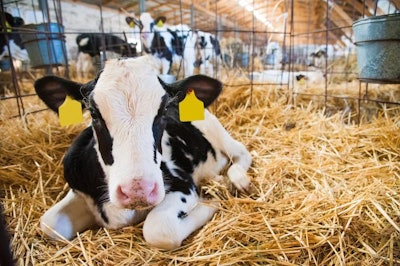
Most feeding guides for dairy heifers recommend calves be weaned when they consume at least 3 pounds of dry feed. While this is neither wrong nor right, it assumes all female dairy calves are of Holstein origin, which is true for the majority of dairy animals worldwide. But, if we are to be correct, we must either make this statement along with the above guideline or provide a more accurate index.
The smallest commercial dairy cattle breed is that of Jersey, with a mature cow weight around 1,000 pounds. In contrast, the heaviest Holstein cow can weigh almost the double that, with the norm being around 1,800 pounds or thereabouts, depending on specific genetics. Nevertheless, a Jersey cow will give birth to a 55-pound calf, whereas a Holstein calf will weigh about 90 pounds. If we accept weaning cannot take place before six weeks of age, we accept a norm of weaning at about eight weeks.
At eight weeks, a Holstein heifer will, or should, weigh about 180 pounds – double her birth weight. At the end of the eighth week, at 180 pounds, the average dry matter intake is 3% of body weight (highly inaccurate, but serves as a guideline for our purposes). This is equal to 180 x .03 = 5.4 pounds of dry matter. Assuming this heifer consumes 14 pounds of liquid milk replacer a day (an average program), plus a starter feed, plus some high-quality roughage source, we expect her to consume 14 x .125 = 1.75 pounds of milk replacer powder dry matter daily and, at best, 0.5 pounds of roughage dry matter, giving a rest figure of 3.15 pounds of starter feed intake, which can translate to about 3.5 pounds of starter feed as is (with 90% moisture). This is how the 3-pounds-per-day guideline has been derived.
At eight weeks of age, a Jersey heifer double her birth weight should weigh at least 110 pounds (with the norm being at least 20 pounds heavier). Even then, at 130 pounds, she would consume at best 130 x .03 = 3.9 pounds of dry matter. In this case, it would be unrealistic to expect such an animal to consume more than 3 pounds of just starter feed before weaning. Such a goal would require this animal to consume virtually no milk replacer and/or roughage, which would be contrary to her physiology. Instead, a more acceptable figure of 1.5 pounds (half of that for Holstein heifers) is considered more acceptable, especially because Jersey calves will require a bit more milk to grow as rapidly as Holstein heifers.
The same figures can be calculated for any other breed, once we know its average (or herd, or genetics) specific birth weight (and its variation). The ideal target at the industry weaning age average should be double the birth weight. With that target in mind, then we can back calculate the amount of dry matter intake possible at weaning, the allowance for milk replacer powder and roughage intake (or allowance). The rest should be covered by a high-quality starter feed. And, as it has been shown by using one of the heaviest and the lightest commercial dairy breeds, the target for the starter feed should be between 1.5 and 3.5 pounds. More is even better, but if this is achieved for the majority of the calves, then either weaning age should be adjusted, or calves should be encouraged to consume more roughage.
The starter feed
Producers of heifers consider milk replacers a necessary expense. They usually invest good money in high-quality milk replacer formulas, but they often tend to underfeed, especially during crucial times (winter, stress, etc.). Roughage is considered an unnecessary luxury that complicates operations in large-scale facilities (and calves end up consuming dirty bedding material, which is normally straw). A bit of high-quality roughage is always recommended and is a good investment if done properly.
Where most producers object is on the expense of the starter feed. Most will buy the least-cost formulation expecting hunger (due to underfeeding of milk replacer) to play its part. After all, heifers are expected to grow in even less dense diets than those offered as a starter feed before weaning. Such feeds are usually home-mixed formulas based on corn and soybean meal, with the addition of the necessary micro- and macro-nutrients. Some will buy or pellet themselves this feed, as this has been shown to somewhat encourage feed intake. But the rewards are rather slim, unless the pelleted form contains other ingredients that increase feed intake though enhanced palatability.
A minority of producers who invest in heavy heifers, and rapid pre-weaning growth rates, prefer to spend a bit more and buy a texturized feed (kind of a muesli type of product). Such feed contains a pellet – usually all the protein sources plus all the dusty micro-ingredients – intermixed with corn flakes, all suspended with a spraying of molasses. Some nutritionists will object to the use of molasses as ruminants cannot digest sucrose, but here we want to feed/develop the rumen bacteria and not the animal, plus molasses increases palatability. It is a common secret that molasses (often with a bit of high-quality oil) will increase feed intake in calves to considerable levels.
In fact, research conducted rather recently indicated that rapid post-weaning growth is associated with up to 2,000 pounds of extra milk yield in the first lactation period. This was a study that did not take into account starter form, but it is obvious that everything that achieves rumen development at the earliest possible time will boost health, welfare and lifetime performance. The same holds true for all animals.

















